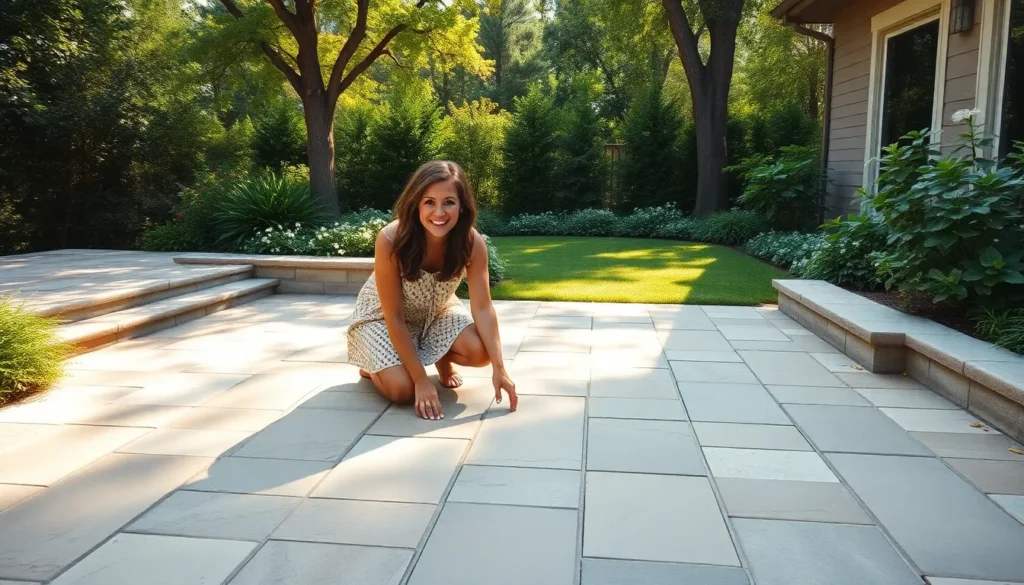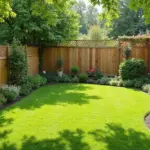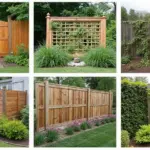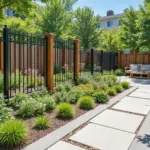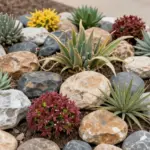Transforming your outdoor space into a stunning patio doesn’t have to expensive or require professional expertise. Paving slabs offer endless possibilities for creating beautiful patios that perfectly complement your home’s aesthetic and lifestyle needs.
We’ve discovered that choosing the right paving materials can completely revolutionize your backyard experience. From sleek modern concrete slabs to rustic natural stone options, today’s paving answers deliver both durability and visual appeal. Whether you’re planning intimate dinner parties or large family gatherings, the right patio foundation sets the stage for countless memorable moments.
Smart paving choices can increase your property value while extending your living space outdoors. We’ll explore creative layout patterns, material combinations, and design tricks that make even modest patios feel luxurious and spacious. Ready to discover how simple paving decisions can transform your outdoor area into your favorite room of the house?
Natural Stone Paving Slabs for Timeless Elegance
Natural stone paving slabs offer unmatched beauty and longevity that synthetic materials simply can’t replicate. We’ve found that these premium materials create stunning focal points while maintaining their appearance for decades.
Limestone Slabs for Classic Appeal
Limestone slabs deliver sophisticated elegance with their smooth textures and neutral color palettes. We recommend choosing from cream, beige, or soft gray tones that complement any architectural style. These slabs typically measure 24×24 inches or 18×36 inches and cost between $8-15 per square foot installed.
Key benefits include:
- Naturally slip resistant surface texture
- Excellent heat resistance for sunny patios
- Compatible with both traditional and contemporary designs
- Available in honed or tumbled finishes
Popular limestone varieties like Cotswold and Portland stone create cohesive outdoor spaces that blend seamlessly with garden landscapes. We’ve seen these materials age gracefully, developing subtle patina that enhances their character over time.
Sandstone Options for Rustic Charm
Sandstone slabs bring warm, earthy tones that create inviting outdoor gathering spaces. We favor varieties like Indian sandstone and Yorkshire stone for their distinctive textures and color variations. These materials range from $6-12 per square foot and offer excellent value for large patio installations.
Popular sandstone colors include:
- Buff sandstone with golden undertones
- Gray sandstone with blue highlights
- Red sandstone with rustic appeal
- Mixed color packs for varied patterns
Riven surface finishes provide natural grip while maintaining authentic stone appearance. We recommend sealing sandstone slabs annually to preserve their color and prevent staining from outdoor elements.
Granite Slabs for Durability and Luxury
Granite slabs represent the pinnacle of paving durability with their exceptional strength and weather resistance. We choose granite for high traffic areas where longevity matters most. These premium slabs cost $15-25 per square foot but deliver unparalleled performance for generations.
Granite advantages include:
- Virtually maintenance free surfaces
- Frost resistant properties
- Scratch and stain resistant finish
- Available in polished or flamed textures
Black granite creates dramatic contrast against light colored homes, while gray granite offers versatile neutrality. We’ve installed granite patios that maintain their pristine appearance after decades of use, making them excellent long term investments for discerning homeowners.
Concrete Paving Slabs for Modern Versatility
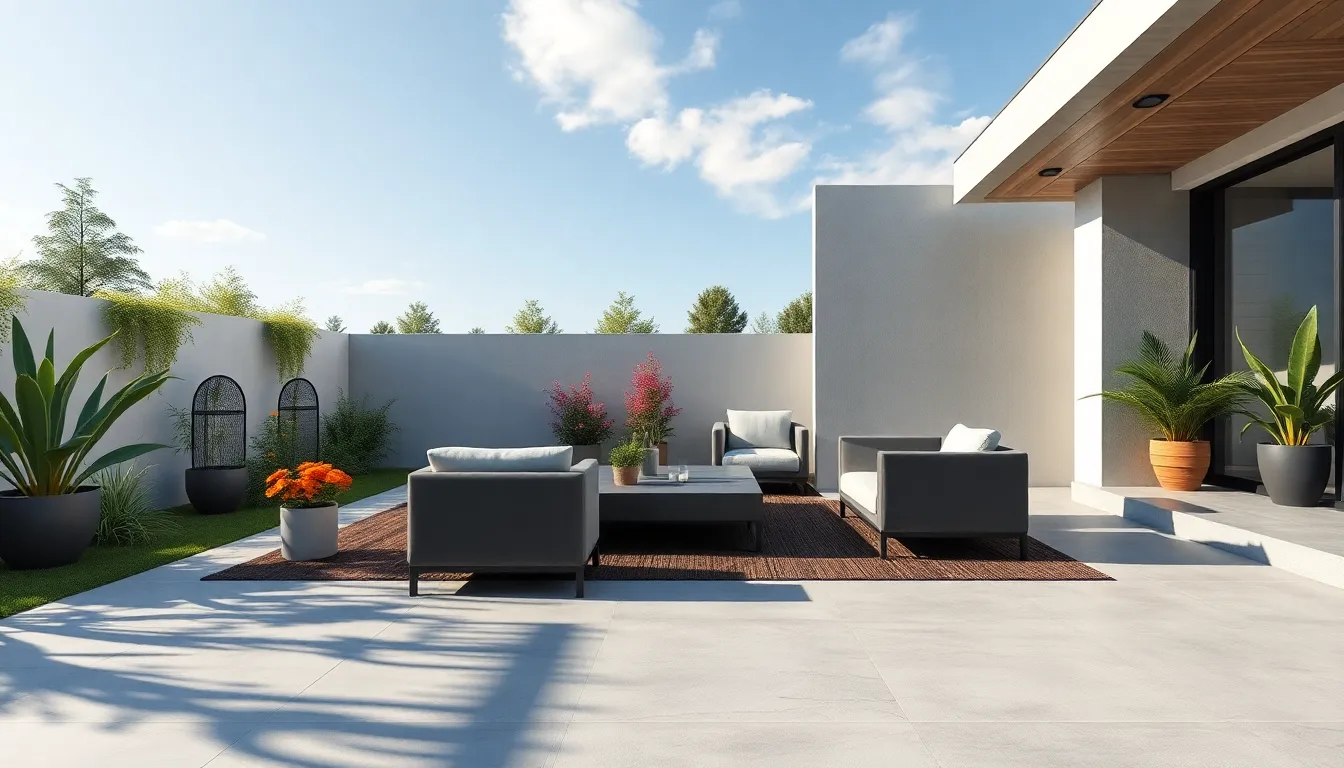
Concrete paving slabs deliver exceptional flexibility for creating contemporary outdoor spaces that perfectly match your design vision. Large concrete slabs like the Para series feature extra-large modern dimensions with hyper-smooth textures, providing sleek aesthetics that work beautifully in minimalist settings.
Smooth Finish Slabs for Contemporary Look
Smooth finish concrete slabs create the refined, polished aesthetic that defines contemporary patio design. We love how these seamless surfaces enhance minimalist outdoor spaces by providing clean lines that feel both sophisticated and spacious. Their polished appearance pairs perfectly with modern outdoor furniture and accessories, creating cohesive design schemes that emphasize simplicity.
The sleek texture of smooth concrete opens up outdoor areas visually, making even compact patios feel more expansive. Modern homeowners appreciate how these slabs align with current design trends that prioritize uncluttered, streamlined aesthetics. Installation becomes straightforward when you choose smooth finishes, as they create uniform surfaces that require minimal maintenance over time.
Textured Concrete for Added Grip
Textured concrete slabs prioritize safety without sacrificing modern appeal, making them ideal for high-traffic patio areas. We recommend these surfaces for patios exposed to weather conditions, as the texturing prevents slipping during wet conditions while maintaining contemporary styling.
Surface texture adds both tactile and visual interest to outdoor spaces, creating subtle contrast that enhances the overall design without overwhelming minimalist themes. These slabs work particularly well in areas where families with children gather, providing peace of mind alongside aesthetic appeal. Textured finishes also hide minor wear and staining better than smooth surfaces, extending the lifespan of your patio investment.
Colored Concrete Slabs for Visual Interest
Colored concrete paving slabs transform ordinary patios into ever-changing outdoor showcases through strategic use of contrasting tones and vibrant hues. We’ve seen how artistic concrete tiles in bold colors can be combined with colorful outdoor furniture to create truly inviting recreational spaces that become focal points of the home.
Color helps define different functional zones within larger patio areas, supporting multi-level and dual-layered design concepts that increase both visual appeal and usability. Homeowners can choose from subtle earth tones for understated elegance or bright accent colors that make bold design statements. These colored options allow you to coordinate your patio with existing landscaping or architectural features, creating seamless transitions between indoor and outdoor living spaces.
Porcelain Paving Slabs for Low Maintenance Beauty

Porcelain paving slabs deliver exceptional durability with minimal upkeep requirements, making them perfect for busy homeowners who want beautiful patios without constant maintenance. Weather resistance, staining protection, and wear durability set porcelain apart from traditional paving materials, requiring less frequent cleaning than natural stone or concrete options.
Wood-Effect Porcelain for Natural Appearance
Wood-effect porcelain slabs bring the warm, organic appeal of timber to your patio while eliminating the drawbacks of real wood. These innovative slabs replicate authentic wood grain patterns and textures, creating inviting outdoor spaces that feel naturally cozy. Moisture resistance protects against rot and warping, while UV stability prevents the fading that plagues natural wood decking. Insect damage becomes a non-issue with porcelain alternatives, giving you the rustic charm without ongoing pest concerns. Installation versatility allows you to create various laying patterns that mimic traditional wood plank arrangements, from herringbone to straight-line designs.
Marble-Effect Porcelain for Sophisticated Style
Marble-effect porcelain transforms patios into elegant entertaining spaces without marble’s fragility and high maintenance demands. These premium slabs capture marble’s luxurious veining and polished finish, delivering sophisticated aesthetics perfect for formal outdoor areas. Durability surpasses natural marble significantly, resisting chips, cracks, and weather damage that typically plague genuine stone installations. Cost effectiveness makes marble-look porcelain accessible for homeowners seeking upscale appearances on practical budgets. Color consistency remains stable across all slabs, eliminating the natural variations that can complicate marble installations and ensuring uniform beauty throughout your patio space.
Large Format Porcelain for Seamless Design
Large format porcelain slabs create sleek, contemporary patios with minimal grout lines that enhance spatial continuity and modern aesthetics. 24″x24″ slabs offer impressive coverage that visually expands smaller patio areas while reducing installation complexity. Fewer joints translate to easier maintenance and cleaning, with less opportunity for dirt accumulation and weed growth between pavers. Design flexibility accommodates both light and dark color schemes, allowing seamless integration with existing architectural elements and outdoor furniture. Contemporary appeal makes large format porcelain ideal for minimalist outdoor designs where clean lines and uninterrupted surfaces create sophisticated entertaining spaces.
Creative Laying Patterns to Transform Your Space
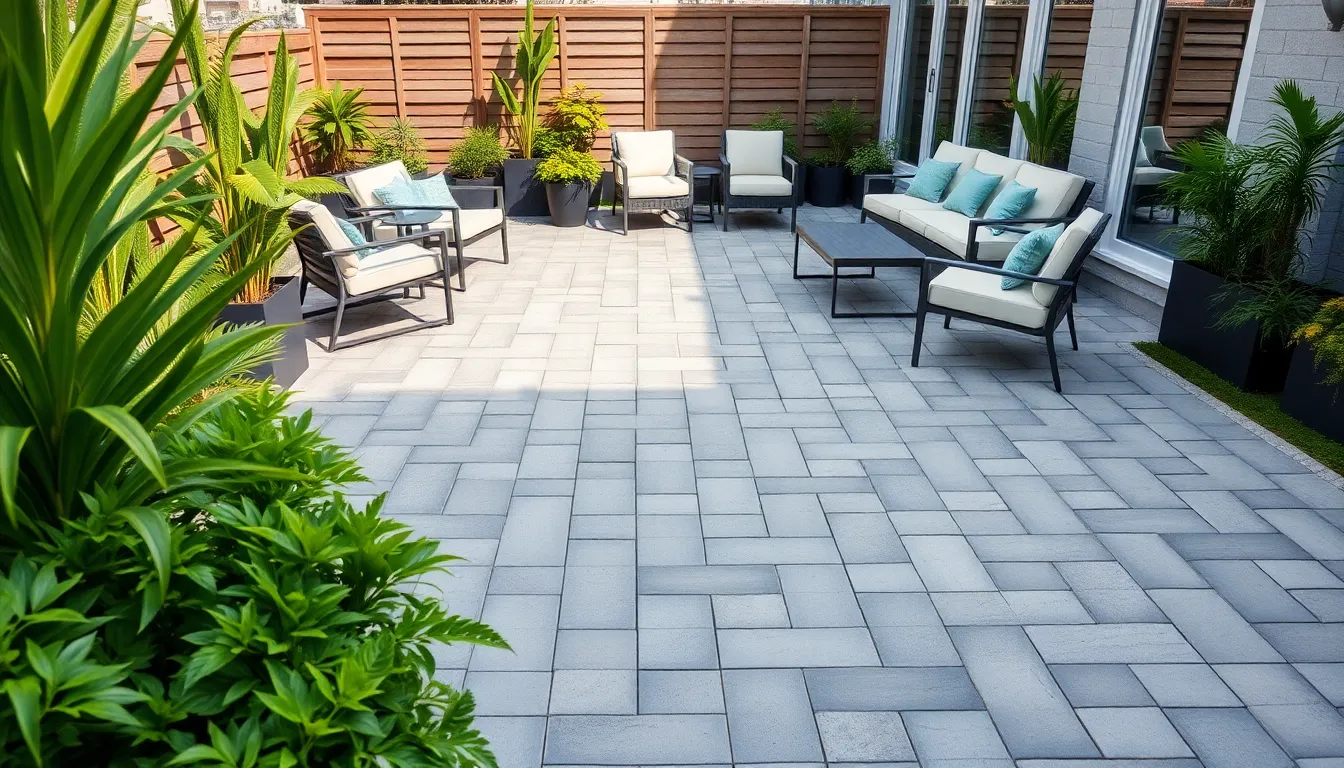
Pattern selection dramatically impacts your patio’s visual appeal and atmosphere. We’ll explore three standout approaches that can completely transform your outdoor space.
Herringbone Pattern for Ever-changing Movement
Herringbone patterns create exceptional visual energy through their interlocking V-shaped design that draws the eye across your patio surface. This classic layout uses rectangular paving slabs positioned at 45 or 90 degrees to your patio edges, forming a striking geometric rhythm that adds movement and sophistication to any outdoor space.
Structural integrity becomes a major advantage when you choose herringbone patterns, as the interlocking design provides superior stability compared to simpler layouts. The pattern works exceptionally well in high-traffic areas where you need both visual impact and long-lasting durability.
Installation flexibility allows for creative expression since you can use various slab materials including natural stone, concrete, or porcelain tiles. We recommend this pattern for busy entertainment areas or spaces where you want to create ever-changing visual interest that complements modern outdoor furniture.
Random Pattern for Organic Flow
Random paving patterns deliver natural, relaxed aesthetics by using slabs of different shapes and sizes arranged irregularly across your patio surface. This approach mimics the organic placement found in natural stone formations, creating an informal flow that softens the overall hardscape design.
Versatility shines with mixed slab combinations that allow you to blend different textures, colors, and materials within a single pattern. The irregular arrangement works particularly well in garden patios where you want to achieve a rustic or freeform design that complements surrounding landscaping.
Visual appeal increases through thoughtful irregularity that breaks up monotonous surfaces while maintaining functional walkways and seating areas. We suggest using random patterns when you want to create a more relaxed outdoor environment that feels naturally integrated with your garden space.
Grid Pattern for Structured Symmetry
Grid patterns provide clean, minimalist aesthetics through straight rows and columns that form structured symmetry across your patio surface. This layout uses uniformly sized square or rectangular slabs positioned side by side and end to end, creating calm, understated elegance.
Modern design compatibility makes grid patterns perfect for contemporary outdoor spaces that feature sleek furniture and architectural elements. The systematic arrangement lends itself to organized entertaining areas where you want clear sight lines and easy furniture placement.
Maintenance advantages become apparent with grid layouts since the uniform spacing simplifies cleaning and potential slab replacement over time. We recommend this pattern for homeowners who prefer orderly, sophisticated outdoor spaces that emphasize geometric precision and contemporary style.
Mixed Material Combinations for Unique Character
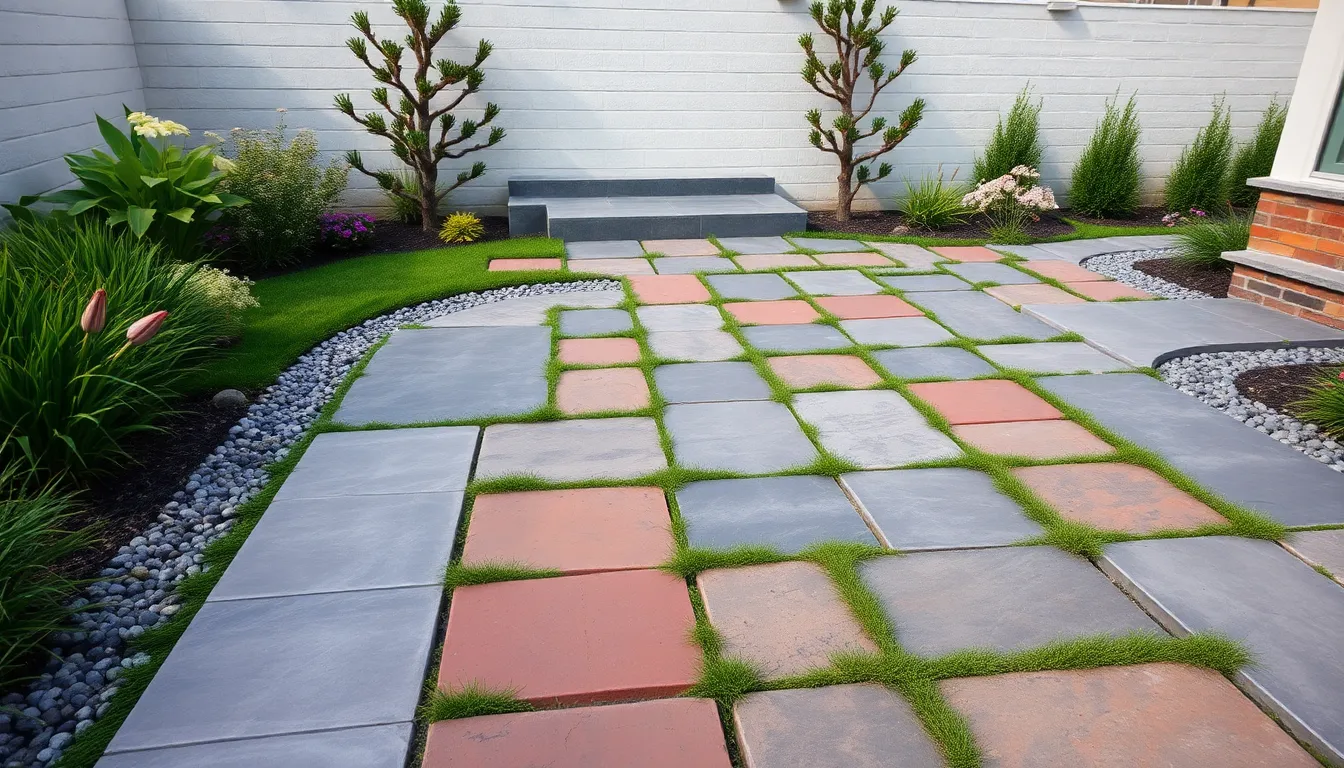
We can create stunning outdoor spaces by thoughtfully combining different paving materials for added visual interest and character. Blending various hardscape elements like concrete, natural stone, and complementary materials transforms ordinary patios into ever-changing, textured environments that showcase creativity and design expertise.
Paving Slabs with Gravel Borders
Gravel borders around paving slabs offer both practical benefits and aesthetic appeal. These borders naturally soften the harsh edges of solid paving while improving drainage and reducing water runoff throughout your patio space. We recommend selecting different gravel sizes based on exact functional needs—larger stones work well along primary walkways for stability, while finer gravel creates comfortable surfaces in lounging areas.
Design flexibility makes gravel borders particularly attractive for homeowners. Popular combinations include concrete pavers with pebble or gravel infill, which adds natural permeability and visual softness to otherwise rigid surfaces. The mixture establishes a relaxed, natural atmosphere that enhances your outdoor ambiance while maintaining practical functionality.
Stone Slabs with Grass Joints
Grass joints between stone paving slabs create seamless transitions between built and natural environments. This technique breaks up the rigid appearance of traditional stone paving while introducing fresh green accents that evoke a garden atmosphere. We find this approach particularly effective for patios that need to blend harmoniously with surrounding landscaping.
Functional benefits make grass joints an intelligent design choice. The living joints promote better drainage and permeability while helping reduce heat buildup on patio surfaces by increasing breathable areas. This natural integration creates inviting spaces that feel less constructed and more organically connected to your outdoor environment.
Contrasting Colors for Bold Statements
Bold color contrasts in paving materials create striking visual focal points and ever-changing layouts. We achieve dramatic effects by pairing materials with opposing tones—sleek gray concrete pavers with bright white or black infill materials produce modern, eye-catching results. These contrasting combinations emphasize geometric patterns and borders while establishing clear design statements.
Strategic color pairing produces sophisticated outdoor aesthetics. Combining warm rusty stone hues with cool gray slabs creates striking, refined appearances that work well in both contemporary and transitional settings. The contrast helps define different functional zones within your patio while maintaining visual cohesion throughout the entire outdoor space.
Size and Shape Variations for Custom Design
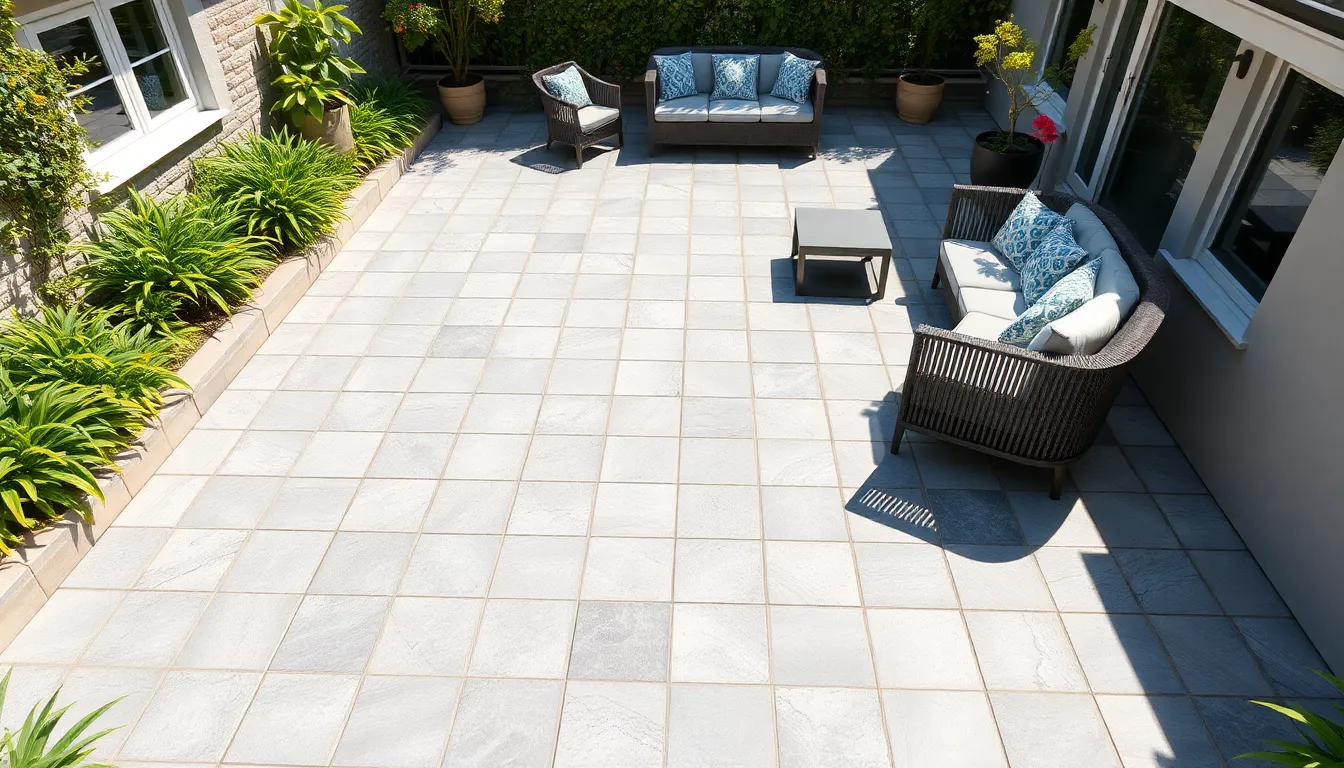
Selecting the right slab dimensions and shapes creates distinctive patio experiences that reflect your personal style. Strategic sizing choices can dramatically transform how your outdoor space feels and functions.
Large Format Slabs for Spacious Feel
Large format slabs instantly create an open, expansive atmosphere in any patio design. We recommend porcelain slabs for their exceptional durability and striking appearance in oversized formats, delivering premium finishes with bold color options that command attention. Reducing joint lines through larger slabs enhances the seamless, continuous feel that makes even compact patios appear more spacious.
Contemporary outdoor spaces benefit tremendously from these generous dimensions, as they establish clean sight lines and uninterrupted surfaces. Natural slate slabs offer another compelling option for large format applications, providing unique character through their irregular edges while maintaining substantial coverage areas. Modern dining areas and courtyards gain sophistication when we incorporate these expansive pieces that create visual weight and presence.
Small Square Slabs for Intricate Patterns
Small square slabs unlock creative possibilities for detailed geometric arrangements that showcase craftsmanship. These compact units excel in traditional and classic garden layouts where precision matters most. Single-size stack bond patterns become achievable with uniform squares, adding texture and visual complexity to your patio surface.
Increased joint lines from smaller slabs create opportunities for contrasting grout colors that highlight your chosen pattern. Checkerboard arrangements deliver timeless appeal, while basket weave configurations add sophisticated movement across the paving surface. Traditional outdoor spaces gain authenticity through these time-tested dimensions that allow for meticulous attention to detail.
Rectangular Slabs for Linear Layouts
Rectangular slabs excel at creating directional flow through stretcher bond and running bond arrangements. These linear patterns guide movement naturally through your patio and surrounding garden areas while maintaining clean, contemporary aesthetics. Multi-sized rectangular combinations within mixed pattern layouts generate ever-changing surfaces that avoid monotonous repetition.
Contemporary and minimalist design philosophies align perfectly with rectangular formats that emphasize horizontal or vertical lines. Practical benefits include easier installation planning and efficient material usage across most patio configurations. Mixed-size paving packs containing various rectangular dimensions offer personalized layout flexibility that balances both functional requirements and aesthetic preferences.
Budget-Friendly Paving Slab Solutions
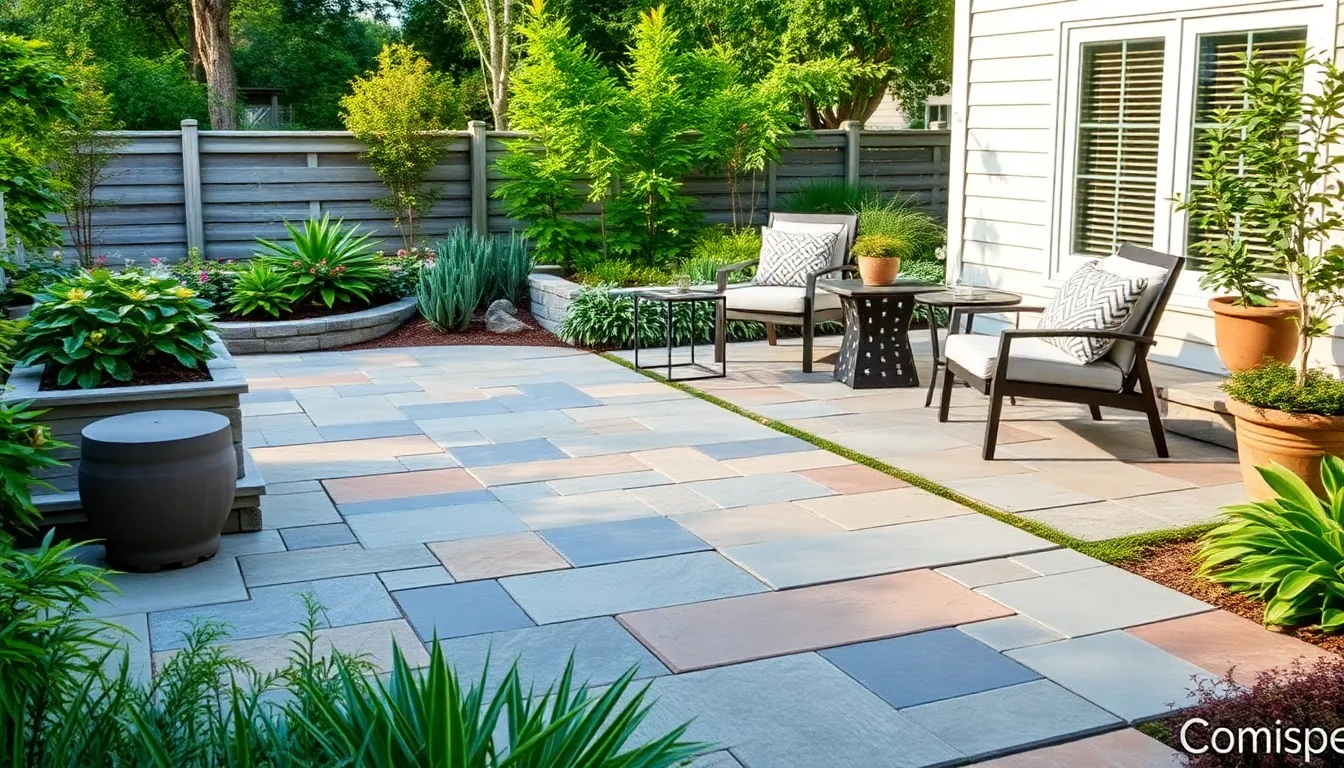
Creating an elegant patio doesn’t require very costly when we choose smart material options and creative approaches. We’ll explore cost-effective answers that deliver both style and functionality.
Reproduction Stone for Affordable Luxury
Reproduction stone pavers deliver the sophisticated appearance of natural stone at a fraction of the cost. We can achieve upscale aesthetics through concrete or composite materials designed to mimic luxury stone finishes. Multi-color concrete weave paver slabs create sophisticated pattern effects that transform ordinary patios into stunning outdoor spaces.
These manufactured alternatives offer consistent sizing and coloring that natural stone often lacks. We find reproduction stone particularly effective for homeowners seeking the elegance of limestone or sandstone without the premium price tag. Brand options include various patterns and colors that simulate high-end materials while maintaining budget consciousness.
Installation becomes simpler with reproduction stone since manufacturers design these pavers for consistent dimensions. We recommend combining different reproduction stone colors to create custom patterns that enhance visual interest without expensive natural materials.
Basic Concrete Slabs for Cost-Effective Coverage
Plain concrete slabs rank among the most economical patio paving options available today. We can pour concrete into various sizes and shapes, creating versatile foundations that adapt to any patio design. Small backyard patio projects benefit from simple concrete pads with minimal embellishments for clean, functional outdoor spaces.
Concrete’s adaptability allows for future enhancements through staining, stamping, or decorative edging. We often recommend starting with basic concrete slabs then adding aesthetic elements as budgets allow. This approach provides immediate functionality while preserving options for later upgrades.
Large concrete slabs minimize installation time and reduce labor costs compared to smaller individual pavers. We find concrete particularly suitable for modern patio designs where clean lines and minimalist aesthetics take priority over ornate patterns.
Reclaimed Slabs for Sustainable Style
Reclaimed paving slabs sourced from demolished patios or pathways contribute to sustainable landscaping through material recycling. We can discover these treasures at building material stores or online marketplaces offering discounted options. Neighbors’ demolition projects and remodeling sites provide excellent sources for broken concrete and salvaged bricks.
Using reclaimed stone or concrete slabs adds vintage character while reducing environmental impact. We recommend combining reclaimed materials with inexpensive fill options like pea gravel or small river stones for maximum cost savings. Laying weed barrier fabric first, then placing pavers in grids with 2-3 inch gaps filled with gravel creates attractive, budget-friendly surfaces.
Creative combinations of reclaimed slabs with gravel or grass produce unique, eco-friendly patio designs. We find modular approaches using reclaimed materials particularly effective for creating patterns that add visual interest without expensive new materials, making small patios both appealing and environmentally responsible.
Installation Tips for Professional Results
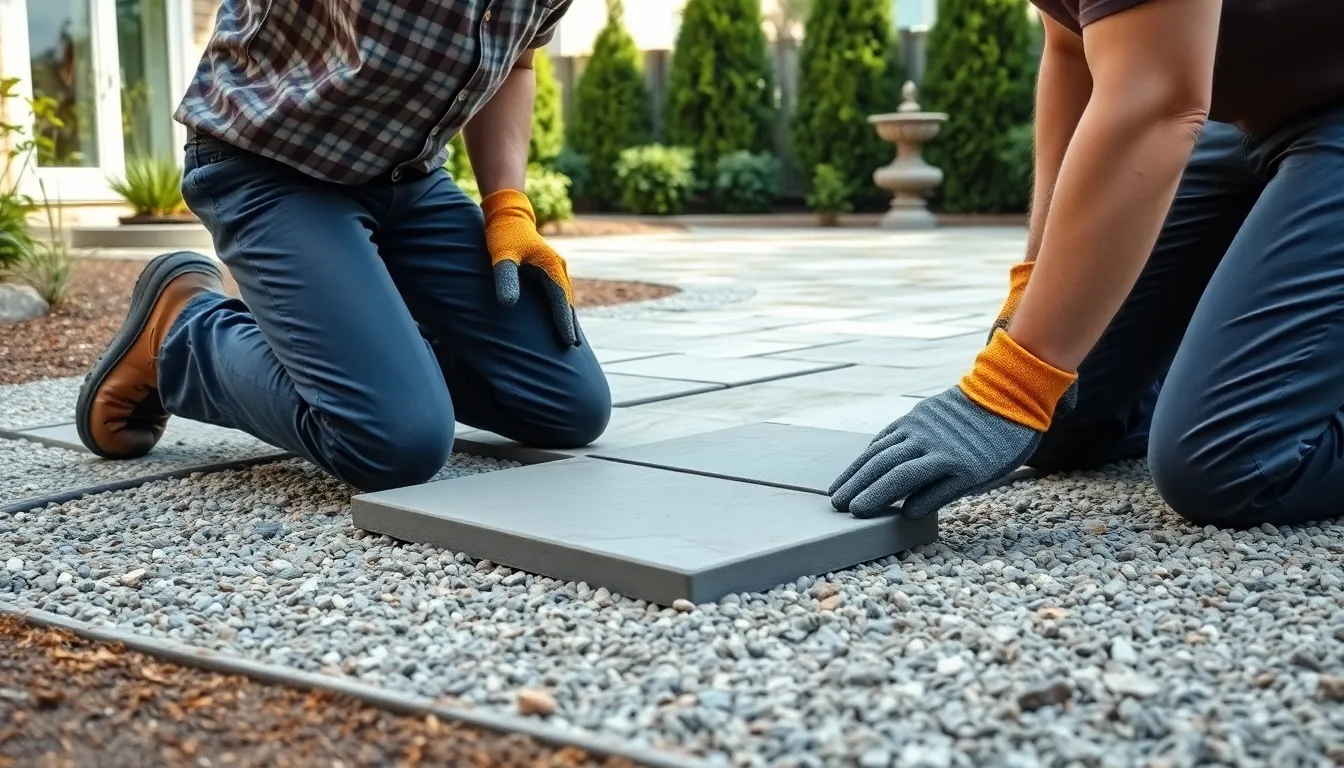
We’ve covered the aesthetic aspects of paving slab selection, and now it’s time to focus on the technical foundation that ensures your patio stands the test of time. Professional installation techniques make the difference between a beautiful patio that lasts decades and one that requires costly repairs within a few years.
Proper Base Preparation Techniques
Excavation depth determines your patio’s long term stability. We recommend digging to approximately 200mm depth to accommodate all necessary layers including the paving slabs themselves. This depth provides adequate space for proper drainage and prevents future settling issues.
Sub-base installation creates the foundation for everything above it. Crushed stone or gravel should be compacted in layers no thicker than 100mm at a time to achieve maximum density. We use a plate compactor to ensure even compression across the entire area.
Slope creation prevents water damage and extends patio lifespan. The base should slope away from buildings at approximately 1/8 inch per foot to channel water runoff effectively. This gradient appears minimal to the eye but provides crucial drainage protection.
Bedding layer preparation varies by slab type and installation method. Concrete slabs typically require a 50mm mortar bed for stability, while some installations benefit from a 25mm sand layer for easier adjustments during placement.
Spacing and Leveling Considerations
Joint spacing between slabs accommodates thermal expansion and prevents cracking. We maintain consistent gaps of 2-5mm for most paving applications, though larger natural stone slabs may require slightly wider joints depending on the material’s expansion characteristics.
Leveling each slab individually ensures a professional finished appearance. A rubber mallet and spirit level become essential tools for this process, allowing us to achieve flush surfaces between adjacent slabs while maintaining the overall drainage slope.
Edge restraints prevent long term movement and maintain clean borders. Plastic or metal edging systems keep slabs properly positioned and prevent gradual shifting that can create uneven surfaces over time.
String lines help maintain consistent alignment across large patio areas. We establish reference points and use taut strings to guide slab placement, ensuring straight lines and proper spacing throughout the installation process.
Sealing and Maintenance Requirements
Sealing protects natural stone and concrete slabs from staining and weather damage. We apply appropriate sealants after installation to enhance durability and often to improve color saturation, with reapplication needed every 3-5 years depending on traffic and weather exposure.
Joint filling locks slabs in position and reduces weed growth. Polymeric sand or mortar fills the gaps between slabs, creating a stable surface that resists both movement and unwanted vegetation growth.
Regular maintenance preserves the patio’s appearance and structural integrity. Sweeping debris weekly, cleaning spills immediately, and inspecting for loose or uneven pieces annually helps identify issues before they become costly repairs.
Seasonal inspections catch problems early and extend patio lifespan. We check for winter damage each spring, looking for shifted slabs, cracked joints, or drainage issues that need attention before they worsen with continued use.
Conclusion
We’ve explored countless ways to create stunning patios using different paving slab materials and design approaches. From natural stone’s timeless elegance to porcelain’s modern durability each option offers unique benefits for your outdoor space.
The creative possibilities are endless when you combine various materials sizes and laying patterns. Whether you’re working with a tight budget or planning a luxury renovation there’s a paving solution that’ll perfectly match your vision and lifestyle needs.
Remember that proper installation and regular maintenance are key to enjoying your new patio for years to come. With the right planning and materials you’ll create an outdoor living space that not only enhances your property value but also becomes your favorite place to relax and entertain.
Frequently Asked Questions
What are the best paving slab materials for patios?
The top paving slab materials include natural stone (limestone, sandstone, granite), concrete, and porcelain. Natural stone offers timeless beauty and durability, concrete provides versatility and modern appeal, while porcelain delivers exceptional durability with low maintenance. Choose based on your budget, aesthetic preferences, and practical needs like traffic levels and climate conditions.
How much do paving slabs typically cost?
Paving slab costs vary significantly by material. Basic concrete slabs are the most budget-friendly option, while natural stone like granite commands premium prices. Porcelain falls in the mid-to-high range but offers excellent value for durability. Reclaimed slabs provide cost-effective vintage charm, and reproduction stone offers natural stone aesthetics at lower prices.
Can I install paving slabs myself or do I need professionals?
Yes, you can install paving slabs yourself with proper preparation and tools. Success depends on correct base preparation, including excavation, sub-base installation, and ensuring proper drainage slopes. While DIY installation is possible, complex patterns or large areas may benefit from professional expertise to ensure long-lasting results.
What laying patterns work best for patio paving slabs?
Popular laying patterns include herringbone for dynamic movement and stability, random patterns for organic flow, and grid patterns for modern symmetry. Herringbone works well with rectangular slabs, random patterns suit natural stone, and grid patterns complement contemporary designs. Choose based on your aesthetic preference and slab shape.
How do I maintain paving slabs once installed?
Regular maintenance includes sweeping debris, cleaning with appropriate cleaners, and resealing when necessary. Inspect joints annually and refill as needed. For natural stone, use pH-neutral cleaners to prevent damage. Porcelain requires minimal maintenance, while concrete may need periodic sealing to prevent staining and weather damage.
What size paving slabs should I choose for my patio?
Large format slabs (24+ inches) create open, contemporary feels and reduce grout lines. Small square slabs allow intricate patterns and work well in compact spaces. Rectangular slabs create directional flow and modern aesthetics. Consider your patio size, desired visual impact, and installation complexity when selecting slab dimensions.
How can I create a patio on a tight budget?
Budget-friendly options include basic concrete slabs, reproduction stone pavers, and reclaimed materials. Mix expensive materials with affordable alternatives, use gravel borders to extend coverage, and consider DIY installation. Reproduction stone offers natural stone looks at lower costs, while reclaimed slabs add character affordably.
What base preparation is needed for paving slabs?
Proper base preparation involves excavating 6-8 inches deep, installing a compacted sub-base of crushed stone, adding a sand bedding layer, and creating proper drainage slopes. Edge restraints prevent slab movement, and proper joint spacing allows for expansion. This foundation is crucial for preventing settling and cracking.

